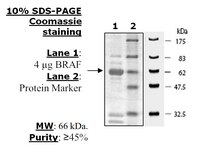14-530M-D Sigma-AldrichBRAF
Recombinant human BRAF, amino-acids 417-766 (end) with N-terminal GST-tag, for use in enzyme kinetics, screening inhibitors, and selectivity profiling.
More>> Recombinant human BRAF, amino-acids 417-766 (end) with N-terminal GST-tag, for use in enzyme kinetics, screening inhibitors, and selectivity profiling. Less<<Recommended Products
Overview
| Replacement Information |
|---|
| Description | |
|---|---|
| Catalogue Number | 14-530M-D |
| Brand Family | Upstate |
| Trade Name |
|
| Description | BRAF |
| Overview | Recombinant human BRAF, amino-acids 417-766 (end) with N-terminal GST-tag |
| References |
|---|
| Product Information | |
|---|---|
| Presentation | 40 mM Tris-HCl, pH 8.0, 110 mM NaCl, 2.2 mM KCl, 16 mM Glutathione, 20% glycerol, and 3 mM DTT |
| Quality Level | MQ300 |
| Physicochemical Information |
|---|
| Dimensions |
|---|
| Materials Information |
|---|
| Toxicological Information |
|---|
| Safety Information according to GHS |
|---|
| Safety Information |
|---|
| Storage and Shipping Information | |
|---|---|
| Storage Conditions | Stable for > 6 month at –80°C from date of receipt. |
| Packaging Information | |
|---|---|
| Material Size | 250 μg |
| Transport Information |
|---|
| Supplemental Information |
|---|
| Specifications |
|---|
| Global Trade Item Number | |
|---|---|
| Catalogue Number | GTIN |
| 14-530M-D | 04055977276602 |
Documentation
BRAF Certificates of Analysis
| Title | Lot Number |
|---|---|
| BRAF -Q2609002 | Q2609002 |
Brochure
| Title |
|---|
| New Products Flyer- Vol 4 Signaling Feature- NEW! Phosphohistidine Antibody |
Posters
| Title |
|---|
| Post-Translational Modifications |








